Ryan Hall's Blog, page 195
December 12, 2016
Nike Launches Program to Break 2-Hour Marathon Barrier in 2017
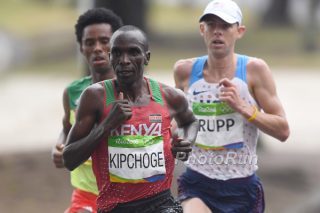
Eliud Kipchoge dominated the 2016 Olympic marathon in Rio de Janeiro. Can he become the first runner to break 2 hours for 26.2 miles? PhotoRun.net
As men’s marathon times have gotten faster in the past decade, there has been a lot of discussion, several books and countless social media posts about the possibility of someone, some day breaking the still mostly unfathomable 2-hour barrier.
The discussion often focuses on whether it’s humanly possible and, if so, what kind of training advancements, racing conditions and gear innovations would it take to get there. Well, Nike not only thinks it’s possible, it’s also going to put three of its best marathoners—Eliud Kipchoge of Kenya, Lelisa Desisa of Ethiopia and Zersenay Tadese of Eritrea—in position to break it in 2017.
Nike only announced limited details of its “Breaking2” program, but it is likely those three athletes will run 26.2 miles in a time trial setting sometime in 2017—either on a track or closed road course—but not affiliated with an actual marathon race. The brand has proclaimed this program, known as “an innovation moonshot designed to unlock human potential.”
“This great story reminds us that inspiration—complete belief in an impossible goal—is at the core of human potential,” Nike announced in a release today. “After all, as Bill Bowerman, Nike’s co-founder and legendary track coach, once said, ‘The real purpose of running isn’t to win a race, it’s to test the limits of the human heart.'”
The current world record in the men’s marathon is 2:02:57, set in September 2014 by Dennis Kimetto at the Berlin Marathon. That was the third time the record had been lowered since Ethiopian great Haile Gebrselassie first broke the 2:04 barrier in Berlin in 2008.
To break the 2-hour barrier, a runner would have to run 3 percent faster than the current record, running roughly 7 seconds faster per mile and average about 4:34 per mile.
RELATED: A Sub-2-Hour Marathon Could Happen Sooner Than You Think
Kipchoge, 32, considered by many to be the world’s top marathoner, ran his PR of 2:03:05 last April at the London Marathon. Since 2014, he has won five marathons at 2:05:00 or faster and won the gold medal in the event at the 2016 Olympics in Rio de Janeiro in 2:08:44.
Tadese, 34, has only run 2:10:41 in the marathon, but he holds the world record for the half marathon (58:23) and won five world championships at that distance. He placed eighth in the 10,000m at the Rio Olympics.
Desisa, 26, ran a 2:04:45 marathon in his debut at the distance in 2013 and won the Boston Marathon in 2013 and 2015.
RELATED: A Review of Ed Caesar’s “Two Hours” Book
The post Nike Launches Program to Break 2-Hour Marathon Barrier in 2017 appeared first on Competitor.com.
December 9, 2016
The Woman Who Ran All Over the Globe in Record Time
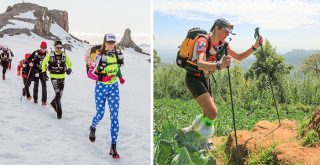
Jax Mariash Koudele endured some epic challenges while running ultra-distance races across Sri Lanka, Namibia, China, Chile, and Antarctica during 2016. Photos: Myke Hermsmeyer, 4Deserts.com
Globe-runner“The landscapes I crossed in Sri Lanka, Namibia, China, Chili, and Antarctica were simultaneously spectacular and brutal,” says Jax Mariash Koudele, who last month became the first woman to finish the 4 Deserts Grand Slam Plus. “For instance, in Sri Lanka, the first weeklong race of the series, it was often 99 degrees with 99 percent humidity, and for the most part, without an established trail through muddy jungle terrain.”
Koudele, a 36-year-old professional ultra-runner representing the U.S. and Canada, set a world record by becoming the first woman to finish the series of five 250K (155 miles) ultramarathons over one year across some of the harshest terrain in the world. Not only did she nail her goal of finishing the series, she was also crowned the 2016 4 Deserts World Champion after placing first in four of the five races.
“If you can imagine literally pushing your way through sticks—that was the first 10K,” Koudele says. “It’s a place that’s just not meant for running.” Before she’d even run 4 miles, she fell into a leaf-covered hole, like a trap, where she was stuck until another runner pulled her out—her legs bloodied and scraped, but otherwise OK.
After emerging from the jungle, she headed into the Sri Lanka highlands, “a lush landscape of green mixed with tea fields and huge Buddha statues everywhere,” she says. “It really reminded you to be mindful.”
However, without the protection of the jungle canopy, the scorching sun and heat brought on extreme dizziness. “I thought, ‘What am I doing out here—this is crazy.’” She trundled up a couple of switchbacks before collapsing and puking. Each time she tried to get back up, she’d fall again, puke again. So, she crawled for a little while. Eventually she made it to the first checkpoint, where they gave her an anti-nausea pill.
“At that point I had to make a decision,” she says. “I could either quit or I could honor the Lyme patients that I was running for.”
One of the reasons she was competing was to support the LymeLight Foundation, which aims to raise funds to provide medical grants to children and young adults to treat their Lyme disease, which has affected some of her closest friends.
“I decided to manipulate my thoughts,” she says—a strategy she’s honed over many years to overcome adversity. “I imagined I was starting the race over.” While dizziness plagued her throughout all seven days of the race, she finished in second place, even after spraining her ankle on day three.
Each subsequent leg of the series presented unforeseeable challenges, like when the soles of her shoes melted in China’s 130-degree Gobi Desert—one of the hottest days of the event on record. But slogging through the desolate, glacial terrain of Antarctica, the last race, topped them all. “It was the hardest run I’ve ever done in my life,” she says. “The snow was sloshy instead of icy. Your feet hurt from lifting them out of the snow over and over again. On day one, I was crying with severe IT band pain and utter exhaustion. By the end of each day, you’re just ripped apart.”
But the scenery, she says, was mind blowing. “I especially enjoyed running on Damoy Point, a small island with a penguin colony,” she says. Some of the penguins fell in line behind the runners, as if they too were part of the race. “We also heard avalanches in the distance and watched pieces of glaciers breaking off and crashing into the sea. I still cannot believe that I saw that with my own eyes versus it being in a National Geographic article.”
As she took those last snowy steps toward the final finish line, she cried in relief. “I was in total shock that I’d made it, that I was safe, and that I’d surpassed all my goals. I’d dreamed of doing something like this since I was 8 years old,” she says, when she won her first medal in a race.
RELATED: Runner with MS Attempting to Run 7 Marathons on 7 Continents in a Year
Wonder Woman
Growing up in Denver, Koudele turned to running—pretending she was Wonder Woman—to give her strength to cope with challenges. “Wonder Woman has been my hero since I was little,” Koudele says. “She spun around and emerged in this radical, magical outfit. She was a woman and she was conquering the world.”
Over the years, the superhero has become Koudele’s personae, and sometimes, she even races in custom-made WW attire (including the metal bracelets) hoping to inspire others to tap into their own superpowers.
“I feel like I’m running for more than myself,” she says. “Things that you think are impossible are not. You CAN do them.”
Her own superpower, she believes, is grit—a dogged determination to just keep moving toward your goals, which she says everyone can develop. “Ultrarunning is 90 percent mental. You can’t listen to the bird on your shoulder saying ‘just quit.’ You gotta flick ‘em off. There’s always a way to get through problems.”
In addition to using affirmations such as just fucking do it, Koudele has learned to smile when things really hurt. “If you’re frowning, your whole body behaves that way. But if you smile, your body chemistry has no choice but to support it.”
Since her victory just over a week ago, she’s hatching new goals, which include expanding Stoked Roasters—a premium coffee roasting company that she launched in 2014 in Hood River, Ore., where she lived part-time before recently moving to Park City, Utah. Its mission is to inspire people to get outside.
“We know athletes want a really good cup of coffee,” she says. “We’re obsessed with making exceptional roasts for outdoor enthusiasts.”
With Wonder Woman behind the brew, perhaps we should all get stoked.
RELATED: Running Around the World in 7 Days
The post The Woman Who Ran All Over the Globe in Record Time appeared first on Competitor.com.
Is It Wrong to Be Disappointed by a New Marathon PR?
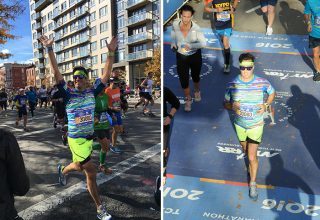
David Bowles acknowledges a friend while running through Brooklyn en route to a new PR at the 2016 New York City Marathon on Nov. 6.
I suppose I should start by saying that I never intended on becoming a runner, let alone a marathoner. Frankly, as athletic as I was growing up, running was just one of those things I could not do. At age 35 I decided to pick up the hobby as a way to get more active and take advantage of Prospect Park in Brooklyn.
I started late in the game, as many current runners do, with a couch-to-5K approach. With the target goal of being able to regularly run a 5K. Maybe not with ease, but consistently. Really, I was just trying to get healthy and stay active.
Cut to this year. I signed up and ran my second New York City Marathon on Nov. 6. For those of you who haven’t run it, it really does live up to the hype. The crowds, the cheering, the support. All top-notch. That being said, it is still a marathon.
PHOTOS: Experience the Energy of the New York City Marathon
When I ran NYC for the first time in 2014, it was my second marathon. So I set the goals of running the whole thing and beating my first ever marathon time. Despite headwinds at every turn and the overwhelming tunnel vision that creeped in on 5th Avenue, I was successful in both of these endeavors. It was truly an overwhelming experience. One, which I swore I wasn’t going to try and repeat.
Well, I didn’t really stick to that plan and decided in 2016 to run NYC for the second time. Mainly as a way to stay motivated. I’ve discovered over my short running career, that I need goals. This year I gave myself a PR window to shoot for. I spent 2015 trying to increase my pace and I felt confident that I could not only better my 2014 time, but also crush it. I set out to beat my previous time of 4:21 with a reach goal of sub-4 hours. That would mean bettering my per mile pace by nearly a minute—which is definitely ambitious, but based on previous half marathons, not so far out of reach.
Due to work and weather this summer training became incredibly tricky. I wasn’t able to regularly get in my weekly mileage, nor was I able to hit all of my long runs. However, I got a solid 20-miler in before my taper and I felt great and relaxed.
RELATED: 5 Last-Minute Tips for Running the New York City Marathon
Now, on to the race. This year’s marathon felt very crowded. Maybe it was because I had moved up in waves or there really were a lot more people than 2014. I felt rushed and a little more frantic getting to the start and hadn’t really gone through all of my normal prep (which truthfully isn’t anything crazy).
As I started, I had a game plan in place. Shoot for my reach goal for the first 8 or so miles, back off a little and then push through the end. This was going amazingly well. I was ahead of target and feeling fine. Making great and quick water stops, coming into the half was slightly ahead of even my reach goal. It wasn’t until the top of the 59th Street Bridge that my legs get a little tight. Then the downhill started to take a slight toll on my hamstrings. All things I had noticed the first time.
Backing off and letting gravity do the work I made my way onto First Avenue. All going well, backing off a little on pace. Then it hit me. Mile 18. Muscles started to go sore, and fast. In fear of having my legs lock up completely, I decided to walk through the water stop and give the legs a little rest. It worked for a block or two and then the cramps started to kick back in. Not how I had hoped getting into the Bronx was going to go. I wanted to walk many times in 2014, but was able to push on. Now, I really did have to walk. I resigned to this fact and held on to the notion that I’ve had a hard time passing people in the past who have run walked marathons. So I took this approach for the last 8 miles. A little bit of regret and disappointment every time I had to walk.
RELATED: Understanding a Runner’s Power Data in the New York City Marathon.
As I came up on mile 25, I realized that I could still indeed beat 4:21, but I’d need to run as much of the last mile and a quarter as I could muster. Not an easy task. I made sure to run out of the park and back in. As well as many feet along the way. Once I made it in, I gave myself one last walk before marker 26. I was determined to push through the end.
Crossing the finish line in 4:16:53 was equal parts pain, excitement and disappointment. It felt surreal. I knew I had beaten my time, which I was very happy about. It just felt as if I hadn’t truly given it my all. As if somehow my need to walk was a failure because it didn’t fit into my overall plan.
As the days have gone on, I’ve come to terms with both of these things. Is it frustrating that I didn’t hit my “reach” goal? In short, yes. Probably more so, because I was so far ahead at one point. Should I let this overshadow my whole experience? Absolutely not. It is still a marathon in the books. A fast one, at least for me, at that.
RELATED: Are You Making These Marathon Training Mistakes?
About the author:
David Bowles is a TV Director living in New York City who began running in the spring of 2012. Since then he has completed three marathons and several half marathons. He runs regularly in Prospect Park in Brooklyn and with Iron Runners NYC. Follow him on Instagram: @minivanshoes
The post Is It Wrong to Be Disappointed by a New Marathon PR? appeared first on Competitor.com.
Sneak Peek: 2017 Boston Marathon Celebration Jacket
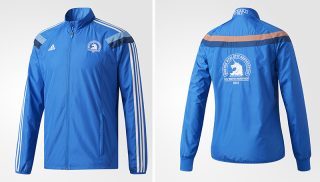
Who’s running Boston in 2017? Here’s your first reason to get excited: Adidas has unveiled the official 2017 Boston Marathon Celebration Jacket. The jacket, which sells for $110, features glow-in-the-dark race graphics embroidered on the left chest and back, along with “B.A.A. 26.2” on the back of the neck. It was made with adidas’ Climaproof technology, which means it’s waterproof and windproof yet still breathable.
“This is the most anticipated reveal in our sport each year, eagerly anticipated by new and veteran runners alike,” said Jack Fleming, marketing and communications director for the B.A.A., in a press release. “The jacket has been created to reward not only the accomplishment but also the hard work necessary to run Boston. If our finishers’ medallion is worn for the hours or perhaps even the day following the historic race each year, then the Celebration Jacket is proudly worn to signify the fact that one has crested the sport in a pinnacle and deeply personal achievement.”
The 2017 Boston Marathon will be held on April 17, but the jacket is available in the U.S. now at adidas.com.
The post Sneak Peek: 2017 Boston Marathon Celebration Jacket appeared first on Competitor.com.
Runner with MS Attempting to Run 7 Marathons on 7 Continents in a Year
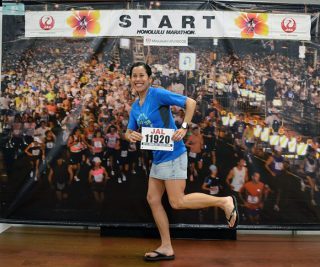
Cheryl Hile poses for a photo at the Honolulu Marathon race expo. Photo: Ronen Zilberman
(c) 2016 Race Results Weekly, all rights reserved. Used with permission.
With Sunday’s 44th Honolulu Marathon fast approaching, San Diego’s Cheryl Hile is just like any one of the 30,000 expected participants: filled with butterflies and excitement and ready to toe the starting line adjacent to Ala Moana Beach Park. Yet her journey is different, unique and special with a story that spans all seven continents.
Living with Multiple Sclerosis, Hile is seeking to become the first person with MS to run seven marathons on seven continents in less than one year. The Honolulu Marathon will be race No. 3 on her year-long quest, which began in South Africa last September and will conclude in New Zealand in June.
“I’m pretty sure I found my mountain with marathons and that desire to conquer it,” Hile told Race Results Weekly.
Hile began running marathons in 2000 and quickly fell in love with the sport. Yet a devastating diagnosis came in 2006 that all but stopped her in her tracks: It was Multiple Sclerosis, a neurological disorder that disrupts the central nervous system and prevents messages from being delivered from the brain to the rest of the body.
“I was using running as my means of therapy for depression, because I was depressed about the diagnosis,” Hile remembers. A disease that impacts 2.3 million people worldwide was only a hurdle for Hile.
Hile continued to run but was hampered by foot drop, a common condition of MS where one can’t lift their foot fast enough to walk (or run) without tripping. A neurologist told Hile to lower her expectations when it came to running, words that both angered and inspired Hile to do more than just finish marathons. She vowed to return and leave a bigger impact on the MS community.
While dealing with foot drop, Hile searched for an orthotist to build a custom orthotic that would allow her to run without falling. In 2008 she’d first don the carbon ankle foot orthotic and experience the thrill of running free of fear. A small brace that runs from her ankle to shin would restore her faith in the sport, eliminating falls, bloody knees, and the thought of stopping.
In the eight years since Hile first wore the brace, she’s completed 38 marathons. Now she’s in the middle of her biggest test yet: seven marathons on seven continents. The Honolulu Marathon will be her 52nd marathon overall.
“When I run I roll on the right side and push off on the left. I’ve been able to continue marathon running, much slower now, because I really only have one side of my body to use and push off of. But that’s been my motivation to keep running marathons,” she said.
It was in July of 2015 when Hile and husband Brian—also a marathoner—came up with the idea of tackling seven marathons on seven continents in a year. Both enjoy running and traveling, and wanted to raise money and awareness for the MS community.
Together they planned an itinerary and agenda, starting with the Cape Town Marathon on Sept. 18, then the Buenos Aires Marathon (Oct. 9), followed by Honolulu (Dec. 11), the White Continent Marathon in Antarctica (Jan. 31-Feb. 4, a date dependent on the weather), Tokyo (Feb. 26), Vienna (April 23) and Christchurch (June 12). The cost would be in excess of $53,000, but the possible funds raised and impact on MS awareness would be without limits. (To date Hile has raised $43,740 of the $53,700 needed for the entire trip on crowdrise.com).
RELATED: Running Around the World in 7 Days
“I’ve always known I’ve wanted to do something big. I wanted to do something to raise money and awareness for Multiple Sclerosis, and this seemed the biggest way,” she said. So far, the quest has had it’s share of ups and downs: the Cape Town Marathon went off without a hitch, full of enthusiasm and excitement, with Hile finishing in 4:54:16. Buenos Aires was a bit of a different story, as Hile was ill with a cold and battled hot weather conditions that exacerbated other MS symptoms like feelings of electric shocks throughout her body. But she finished in 5:06:44, and now she has her eyes on Honolulu.
“Honolulu is one of the biggest marathons in America, it’s up there with New York and Boston and Chicago,” she began. “I’ve done those marathons and I’ve always wanted to do something different. I’ve had friends who’ve run Honolulu and they always talk about how spectacular it is: the organization, the welcoming people, the scenery and in general the whole Aloha Spirit. That’s something I’ve wanted to experience, and the race has been on my bucket list for a very long time. This is just a great opportunity to run Honolulu… Where else can you run a marathon in December?”
RELATED: Bay Area Man Completes Global Marathon Challenge
Hile said she’s looking forward to the trek up and down Diamond Head during the race, a stretch of miles she’s heard have spectacular views and encouraging spectators.
As her dream to conquer seven marathons on seven continents in a year began to take shape and gain steam, Hile connected with other inspiring athletes. Two athletes who she’s gained personal inspiration and advice from are Wendy Booker, the first person with MS to summit Mt. McKinley and six of the seven tallest peaks in the world, and Beth Sanden, the first challenged athlete to do seven marathons on seven continents in a handcycle.
“There have been so many amazing people,” Hile began. “What really touches me most are the people who are newly diagnosed with MS. People have been reaching out to me through Facebook or my blog and they’ve been telling me how they feel better about their prognosis because they know that they can push forward and find ways around difficulties and keep on moving. That’s what really cheers me up and gives me chills. It’s inspiring other people, and that’s really what I wanted to do.”
In Honolulu, Hile aims to finish in the 5-hour range. Once done, she’ll have Africa, South America, and North America checked off her seven on seven journey.
“You want to enjoy and be part of the whole experience,” she said of this race. “That’s really what I’m looking forward to, being part of a large massive group all going for the same goal to finish the marathon. What better place to do that than Honolulu?”
RELATED: Woman With Parkinson’s Runs Boston Marathon
The post Runner with MS Attempting to Run 7 Marathons on 7 Continents in a Year appeared first on Competitor.com.
Visually Impaired Runner Chaz Davis Runs Record-Breaking Marathon
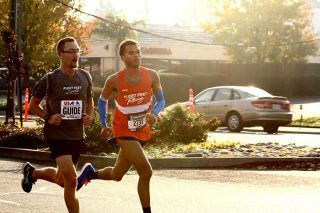
Chaz Davis (right) and his guide, Jacob Huston on their way to a strong finish at the California International Marathon on Dec. 4 in Sacramento, Calif. Photo: Cathi Wallace.
Chaz Davis ran quite a debut marathon on Sunday at the California International Marathon in Sacramento.
While his 2:31:48 result would be a strong effort for any first-time marathoner, his finish time is especially remarkable given that he is visually impaired and that he only really trained for the 26.2-mile distance for about six weeks.
With the aid of his guide Jacob Huston, the 23-year-old Davis, who is legally blind, averaged 5:47 per mile en route to setting a new American record for a debut marathon in the T12/B2 visual impairment category. He was one of 40 blind runners who competed in the U.S. Association of Blind Athletes Marathon National Championships, which is coordinated in partnership with the California International Marathon each year.
Davis and Huston came through the halfway mark in 1:14:45, which is about 5:42 mile pace. That was slightly faster than planned, but the downhill profile of the course and Davis’ fitness made the miles go by with ease.
“I thought I had a chance to break 2:30 because I felt great through about 20 miles,” Davis said. “But from miles 22-25, that’s when my legs got tight and I slowed up a bit.”
Davis’ story is inspiring and empowering. After going blind suddenly halfway through his freshman year at the University of Hartford, he fell into depression, gained weight from a lack of physical activity and struggled to adapt in everyday life. But through the help of friends, family and running, he’s become a world-class visually impaired runner with the potential for more record-setting efforts.
About midway through his first year of college, Davis was stricken with Leber Hereditary Optic Neuropathy (LHON) a rare, incurable genetic disease that causes vision loss. He thought he would never run again, but his teammates encouraged him to get back at it and helped guide him on runs. He wound up running on the cross-country and track teams at Hartford and graduated in May with a degree in criminal justice.
VIDEO: The Inspiring Story of Visually Impaired Runner Chaz Davis
In September, Davis represented Team USA at the Rio 2016 Paralympic Games, placing 10th in the 1,500m in 3:58.28 (roughly a 4:15 mile) and eighth in the 5,000m (15:15:86) and setting personal bests in both events.
Davis recently moved from his hometown of Grafton, Mass. to Denver, for a 10-month study at the Colorado Center for the Blind. Since he moved to Colorado, he’s relied on several guides to assist him in training, either running with him or riding a bike alongside him. His longest run prior to the marathon was only 16 miles, but he learned a lot from his experience and is confident he can run faster.
He plans to turn his focus back to track and field for a while, but he says he’ll definitely run another marathon. Davis was recently awarded the Richard Hunter CIM to Boston Excellence in Running Award, which gives him the opportunity to compete in the Boston Marathon in 2017 or 2018 on an all-expenses-paid “Team With a Vision” program from the Massachusetts Association for the Blind and Visually Impaired.
“I’ve had great support in Denver and that’s what the running community is all about,” he said. “Overall, I felt pretty strong, even though I didn’t have a lot of time after the Paralympics to train for the marathon. I was averaging about 70 to 90 miles per week leading up to it, but I just had to go work with what I had. Honestly, I was surprised that I wasn’t as beat up from the marathon as I thought I would be.”
Davis plans to pursue a master’s degree in social work to help people who have gone through similar experiences to his.
“The blindness has not kept me from my goals and what I want in life,” he said. “I have found a purpose and I want to work with other people like me.”
RELATED: Guiding Amelia: What it’s Like to Guide a Blind Runner
The post Visually Impaired Runner Chaz Davis Runs Record-Breaking Marathon appeared first on Competitor.com.
December 8, 2016
Miller vs. Hawks: How an Epic 50-Mile Trail Race Unfolded
On Dec. 3, Zach Miller and Hayden Hawks went out like gangbusters at the start of The North Face Endurance Challenge 50-Mile Championships in the Marin Headlands north of San Francisco. Those who witnessed the race were left in stunned awe at the effort those two runners put out from start to finish. Miller, a Nike-sponsored runner, wound up winning the race in a course-record time of 5 hours, 56 minutes, 3 seconds, about 2 minutes ahead of Hawks, a Hoka athlete. (That’s 7:07/mile pace on a extremely hilly course almost entirely on trails.) Check out this amazing video from Jamil Coury, Michael Carson and Billy Yang, which captures the action, intensity and drama of the race in vivid detail of Miller and Hawks taking ultrarunning to the next level.
The post Miller vs. Hawks: How an Epic 50-Mile Trail Race Unfolded appeared first on Competitor.com.
2016 Running Store of the Year—Charm City Run, Bel Air, Md.
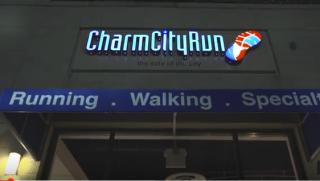
Charm City Run in Bel Air, Md. was named one of the 50 Best Running Stores in America for 2016 and winner of the 2016 Running Store of the Year Award.
RELATED:
RELATED: The 50 Best Running Stores in America for 2016
The post 2016 Running Store of the Year—Charm City Run, Bel Air, Md. appeared first on Competitor.com.
50 Best Running Stores in America 2016—Hanson’s Running Shop, Royal Oak, Mich.
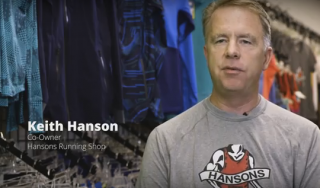
Hanson’s Running Shop in Royal Oak, Mich., was named one of the 50 Best Running Stores in America for 2016 and one of the four finalists for the Running Store of the Year Award.
RELATED: The 50 Best Running Stores in America for 2016
The post 50 Best Running Stores in America 2016—Hanson’s Running Shop, Royal Oak, Mich. appeared first on Competitor.com.
Shoe of the Week: Saucony Freedom ISO

The Freedom ISO is the first shoe to feature a midsole made entirely of Saucony's Everun expanded thermoplastic polyurethane. Photo: Brian Metzler
“Wow, this shoe is all about fluidity, flexibility and fun!”
So said one of our wear-testers after running his first 6-miler in a pair of Saucony’s new Freedom ISO shoe, and for good reason.
In recent years, midsole cushioning compounds have been reinvented and, as a result, running shoes are getting better and more dynamic in their construction and ability. In other words, shoe designers have found better materials to use for midsole cushioning instead of some sort of EVA (ethylene vinyl acetate) foam that dominated the industry for the past 40 years. Saucony is getting lots of love for its Everun midsole compound, a new expanded thermoplastic polyurethane (e-TPU) material that it unveiled late last year. From our experiences wear-testing the Freedom ISO, it’s clear that Everun offers a good amount of energy return and responsiveness as soft, reliable cushioning. (Saucony placed segments of Everun cushioning in several of its Spring 2016 shoes, but the new Freedom ISO is the first shoe with a midsole made entirely from Everun and the first chance to really feel how it performs.) It debuted at stores on Dec. 1, but our wear-testers have been loving it for the past several months.
Like any material in a shoe, it’s less about the specific characteristics on its own and more telling when experienced as part of a shoe in motion on the run. The combination of the Everun midsole and another thin layer on top of the strobel board under the footbed—along with the snug and secure but “barely there” feeling of the lightweight engineered mesh upper and near-custom fit it provides—makes for a delightful experience. With a 4mm heel-toe offset and a modest amount of foam and rubber under the foot (19mm in the heel, 15mm in the forefoot), the Freedom feels close to the ground but not in a minimalist kind of way.
Everun seems to be about 10 percent firmer than adidas’ Boost midsole foam and the difference is evident in the first few strides. (That’s not a crack against Boost, but it is a definitive statement about Everun.) While heel impacts are dampening and accommodating, the roll-through to the toe-off phase feels sublime and extremely fluid and natural. There’s no inherent support in this shoe (except for what your foot provides), but Everun midsole isn’t unstable or wobbly. There’s also no frenzied bounciness the moment after footstrike and nothing to get in the way of your foot’s natural movement, and that results in a soft and smooth-rolling transition to the forefoot. From there, the shoe’s toe spring design and Everun’s energetic demeanor unleash a microburst of coiled energy that launches the foot on the start of the next stride. The bottom line is that it just feels smoother and more lively than most shoes.
The Freedom ISO is not quite as light as Saucony’s popular Kinvara model (the 2016 Kinvara 7 does have Everun foam in certain places), but it’s slightly lower to the ground and its definitely more inherently energetic—and that’s saying a lot. For all of those reasons, the Freedom ISO is a great do-everything shoe, one our testers deemed worthy of long runs, recovery runs, tempo runs, mile repeats and just about everything with maybe the exception of short and fast intervals. A few testers said they’d definitely use it in their next half marathon, while others said it was their go-to shoe for long runs.
This is the shoe for you if … you’re looking for a modern jack-of-all-trades training shoe with a natural feel and energetic ride.
Price: $160
Heel-Toe Offset: 4mm; 19mm (heel), 15mm (forefoot)
Weights: 9.0 oz. (men’s size 9), 8.1 oz. (women’s size 7.0)
Info: Saucony.com
RELATED: Shoe of the Week—New Balance Fresh Foam Zante 2
The post Shoe of the Week: Saucony Freedom ISO appeared first on Competitor.com.
Ryan Hall's Blog
- Ryan Hall's profile
- 21 followers



